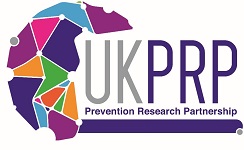Invasive species: a threat to the environment, the economy and public health
Louis Simon, PhD researcher at Queen's University Belfast, discusses invasive species and the threat they pose to the environment, the economy, and public health
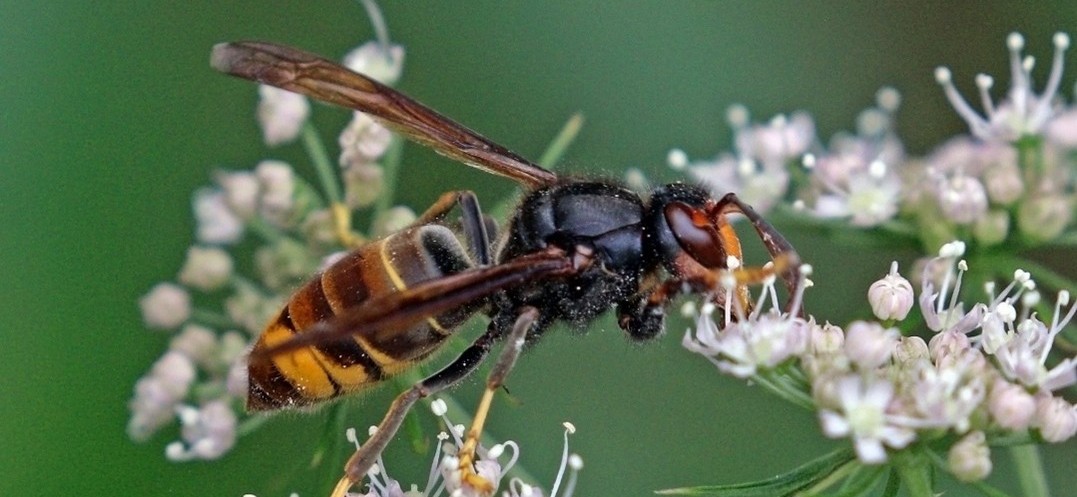
Invasive species are now recognised to have negative impacts on the environment and are a major cause of species extinction - some experts consider they might even be the number one driver of biodiversity loss globally. Invasive species also cause gargantuan monetary costs and pose serious risks for public health. All those impacts are expected to grow in the future as the rate of biological invasions is increasing because of human activities and climate change.
First, what is an invasive species?
The term invasive species refers to a species that has been transported beyond its native range of distribution and that has been introduced in an area it would not be present in naturally, because of human activities. In this new area, where the species is referred to now as introduced, alien or non-native, the species must survive in these new conditions, become able to reproduce and form self-sustaining populations, and eventually spread. Although there are still debates and inconsistencies within the scientific community and “invasion science” experts, the current consensus is that it is at the end of this multi-stage complex process (the whole process is the biological invasion), when the species is spreading in its non-native area, that is referred to as invasive.
The process of biological invasions is not a recent phenomenon. Ever since humans started exploring the earth they, intentionally or not, transported species with them. For example, cats were domesticated 9000 years ago, are now present worldwide and represent a major conservation concern, considered by biologists as one of the most problematic invasive species. However, biological invasions really started to increase with the age of exploration and colonisation, when European civilisations travelled the world while exporting and importing goods and species, for mercantile or recreational purposes. This is, for example, how invasive species such as rats, or some invasive mosquitoes were introduced on the American continent.
The intensification of land-use, urbanisation and global trade has led to the breakdown of natural biogeographic barriers, which now threatens ecosystems and biodiversity worldwide. Intentionally or not. an increasing number of species are transported and are introduced in new areas globally.
How are invasive species transported and introduced in new areas?
Species can be transported and introduced in areas in various ways, referred to as pathways of introduction. Researchers generally consider 6 different pathways of introduction.
- Some species deliberately introduced into an environment. For example, plants can be introduced for ornaments; animals can be introduced as pets or biocontrol (to fight against a pest or another invasive species).
- Some species can be deliberately introduced into a new area but kept in a controlled environment or captivity. For example, plants can be introduced for agriculture, animals can be introduced as pets, livestock, aquaculture or recreational purpose (e.g., fishing, gamebirds). However, it is possible that these species can escape the controlled environment or captivity they are kept in.
- Some species can be introduced unintentionally as a contaminant of commodities. For example, some insects or parasites can be transported in traded timber, pathogens can be transported on traded pets or livestock.
- Some species can be unintentionally transported as stowaways on human transport vectors. For example, ballast waters (water used by ships to regulate their buoyancy during their route, taken in the starting harbour and release at their destination) or biofouling (species attaching or living on ships hulls) are major vectors for species transport.
- Humans can build corridors that link formerly separated areas and allow mass passage and migration of species. For example, a great number of species now invasive in the Mediterranean Sea migrated from the Red Sea after the opening of the Suez Canal.
- Some species can spread to new regions from area they are already invasive in.
Why are invasive species an important issue?
In their non-native range, species can have various impacts, often classified in 3 categories by researchers: ecological, economic and health impacts.
Ecological impacts
There are multiple ways by which invasive species can disturb ecosystems, leading to the decline of native species populations and local extinctions. These potential impacts of invasive species lead to biological invasions becoming a major - if not the main - driver of biodiversity loss globally.
For example, one of the main ways invasive species can disturb ecosystems is through competition. Some invasive species can be more competitive than native species at exploiting resources, reproduction, or occupying the space. An invasive species can also represent a new predator for the native species that either had no predator before (called naïve) or that are not as adapted to fight this new predator as they are for their natural predator. An invasive species can also be (or be a host for) a new pathogen that can be transmitted to the native fauna/flora. Often, the invasive species is adapted to fight - or is asymptomatic - to the pathogens it carries whereas they can be deadly for the native species. Some species have the capacity to alter the general conditions of the ecosystem and make it an unsuitable habitat for the native species.
Economic impacts
Because of the damage they can cause to infrastructure, crops, or because of the large management campaigns enforced to contain them, invasive species are responsible for massive monetary costs. Just in the UK, biological invasions are estimated to have cost between £5.4 billion and £13.7 billion since the 1970’s, over £120 million per year on average (Queen’s University Belfast), with global costs estimated to approximately over a £1 trillion - these numbers are rapidly increasing and are probably underestimations.
Health impacts
Because they are vastly studied, there is a lot of data available on ecological and economic impacts, meaning they are now well understood. However, the impacts invasive species can have on human health are not as studied and there is thus a lack of data and awareness, even among experts. But this does not mean that the health risks posed by invasive species are not significant. This is the focus of my PhD project, carried out at the Centre for Public Health at Queen’s University Belfast, which aims at better understanding the public health risk represented by biological invasions.
Invasive species represent a threat to public health for multiple reasons. Many can be involved in the spread of diseases. For example, biting insects and invasive mosquitoes, in particular, have gathered massive concern over recent years as they are introduced in more areas and can transmit severe diseases to humans such as malaria, zika, dengue, chikungunya, or yellow fever - sometimes causing major outbreaks as it is the case in South America with malaria, dengue or zika epidemics (BBC, CLAS, Healio). Mosquitoes are not the only concern as species such as ticks can vector Lyme disease and snails can host parasites capable of infecting humans.
Invasive animals can also carry zoonotic diseases (a pathogen infecting animals, mainly vertebrates that can also be transmitted to humans). For example, invasive bird populations can represent abundant reservoirs for bird flu. Animals such as raccoons or mustelids were introduced in Europe as they escaped fur industry or pet trade and are responsible for maintaining and/or reintroducing rabies.
Some invasive plants can produce abundant and highly allergenic pollen, sometimes on more extended periods than native species. Some invasive plants also produce allergenic and/or toxic saps. Some animal species can also produce allergenic venom or toxin. For example, invasive wasps and ants can be a great concern for allergic people. Many invasive marine animals such as jellyfishes or lionfishes sting and can inject powerful toxins or venoms and make some recreational areas hazardous, especially in the Mediterranean Sea.
Invasive species can also have more indirect effects on health. For instance, some species can devastate crops or invade water bodies and decrease the availability and/or quality of crucial resources including food and drinkable water.
What about here?
Northern Ireland, as well as the rest of the British and Irish islands, is no exception and has not been spared by biological invasions. Here are four examples of invasive species that can be observed daily in Belfast and, more broadly, in Northern Ireland.
American grey squirrel (Sciurus carolinensis)
The grey squirrel was first introduced in the UK from North America during the 1800’s by wealthy landowners as an ornamental species in parks and gardens. It was first released in Great Britain in Wales in 1828 and was first observed in Ireland in 1911. It has now spread over most of the UK and Ireland and can be very easily spotted in most green areas around Belfast.
The invasive American grey squirrel has caused the decline of the now protected native Eurasian red squirrel. This is because of competition for resources, because the grey squirrel has fewer predators than the red squirrel but also because the grey squirrel carries a pathogen, the squirrel pox virus, to which it is asymptomatic but that is lethal to the red squirrel. Grey squirrels also damage trees by stripping their barks, causing economic losses to the forestry industry. It is now illegal to import, release and keep grey squirrels in captivity in the UK and Ireland.
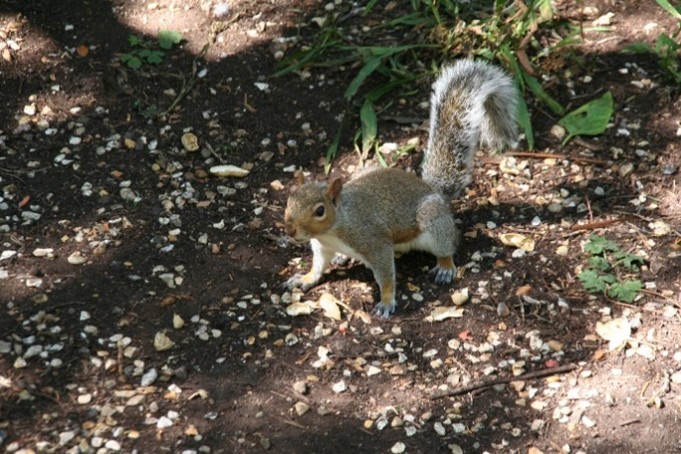
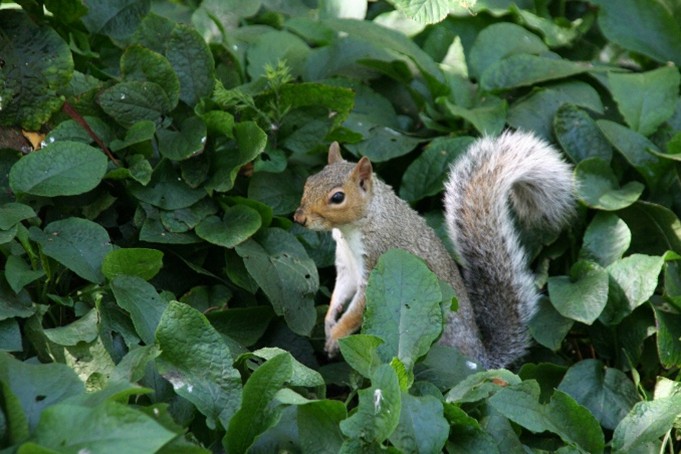
American grey squirrel in Botanic Gardens, Belfast, Northern Ireland (Photo: Louis Simon).
Himalayan balsam (Impatiens glandulifera)
Native from western and central Himalaya (Asia), the Himalayan balsam was first introduced in the UK in 1839 in gardens in London as an ornamental plant. Because it has been intensively transported by humans and because its seeds can travel on long distances, it has then spread to the rest of Britain, Ireland and Northern Ireland, where it is now a major weed problem.
It can rapidly colonise and invade vast areas, mainly riverbanks but also other habitats, even gardens. It has severe impacts on local plant biodiversity as it outcompetes other plants for space and lights, excluding and replacing native species, resulting in large monocultures (community composed of only one species of plant). Due to the exclusion of other plants, the soils are left bare and susceptible for erosion when the Himalayan balsam die back in Autumn. Additionally, Himalayan balsam produces abundant nectar in its flowers and so is perceived as more attractive to pollinators, consequently decreasing pollination (crucial for the reproduction of most floral plants) for native species.
Himalayan balsam can be observed across Northern Ireland. In Belfast, it can be observed in most green areas, notably alongside the Connswater Community Greenway including Orangefield Park, Dixon, and the Hollow where Greenway volunteers organise “bashing sessions” to try to manage and contain it. It has also colonised most of the banks along the Lagan River. It can form vast bushes and cover large areas, sometimes growing as tall as trees.
Because of its tendency to spread rapidly and cause major impacts on biodiversity, it is now illegal to plant Himalayan balsam or introduce it in the wild in the UK, including Northern Ireland.
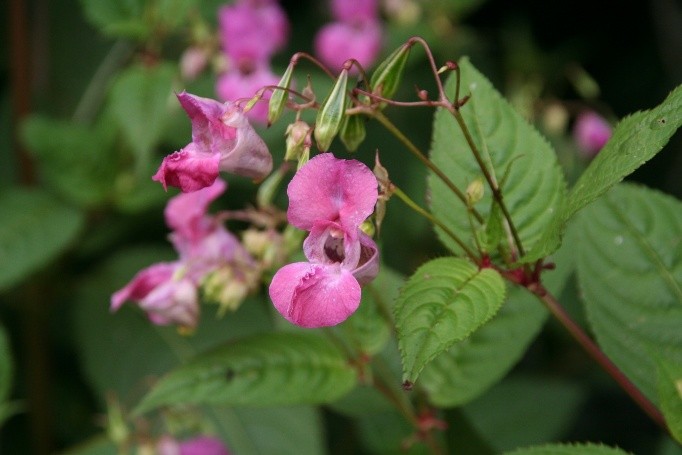
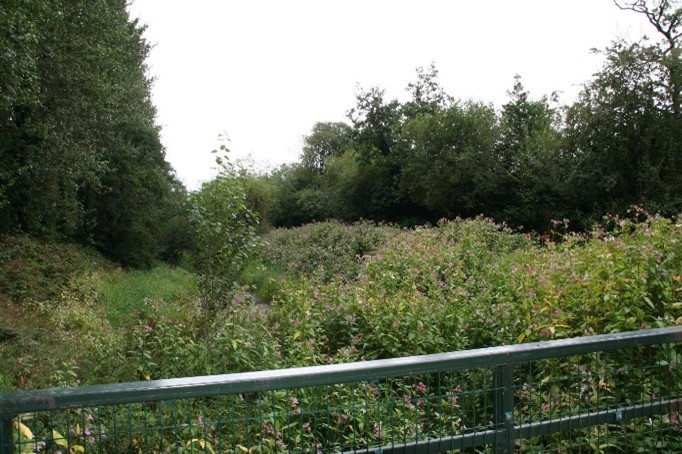
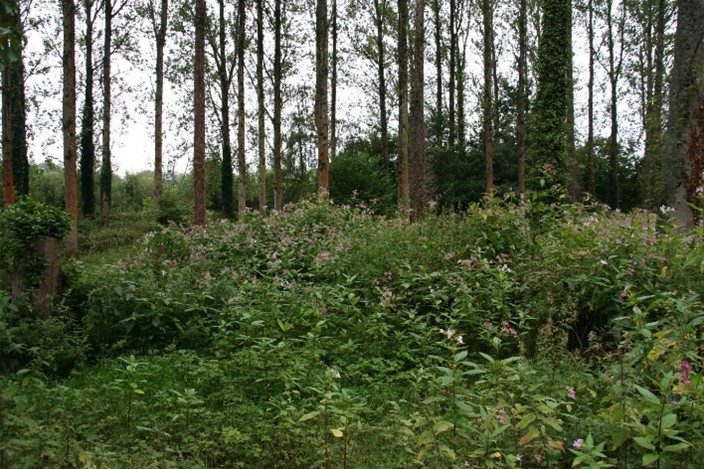
Himalayan balsam along the Lagan River (Belfast, Northern Ireland), where it has colonised most of the banks and replaced native plants (Photo: Louis Simon).

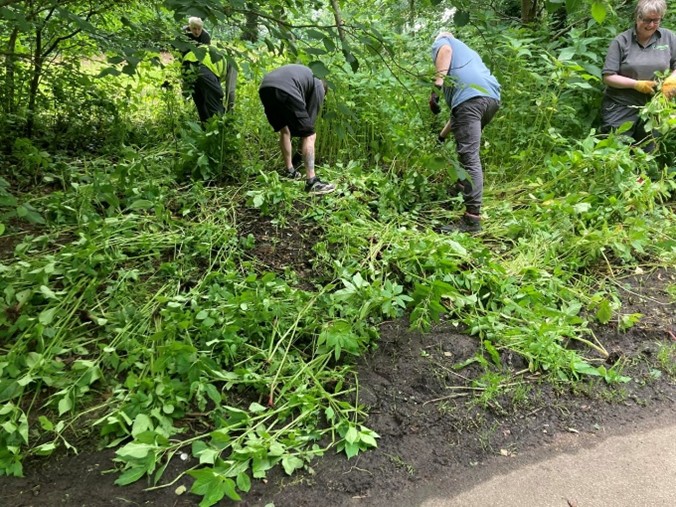
Citizen work and engagement is crucial when managing invasive species and protecting native biodiversity, illustrated here by Greenway volunteers during a Himalayan balsam bashing session (Photo EastSide Greenway).
Giant hogweed (Heracleum mantegazzianum)
The giant hogweed is a species native from South-West Asia introduced in England by 1820 as an ornament in parks, gardens and by rivers. It is now present in the UK and Ireland. Because a single plant can produce large numbers of seeds (up to 50,000) able to be transported by the wind, water or dormant in transported soil (dormant for up to 20 years), it can spread rapidly despite containment effort and grow into plants as tall as trees (up to 5m) with a thick stem and wide flowers (umbels up to 80cm across) and leaves (up to 2.5m across).
Because of the vast and dense clusters in can form, giant hogweed can outcompete native plants for space and resources, reducing native diversity and possibly impacting invertebrates depending on native plant species. Giant hogweed can also significantly affect soil structure and increase erosion of riverbanks. It can also prevent access to water bodies and for example affect fishing activities.
The main impacts of the giant hogweed are related to health. Indeed, it produces a highly phototoxic sap. After contact, the sap of the giant hogweed can cause severe burns that will swell and form blisters when exposed to the sun. The effects of which possibly lasting for years after the burning initially occurred. Citizens should be very careful when approaching this plant, which makes management and volunteering more difficult.
Giant hogweed can be observed across all Northern Ireland. In Belfast, it can be observed in some green or wet areas, such as the banks of the Lagan River.
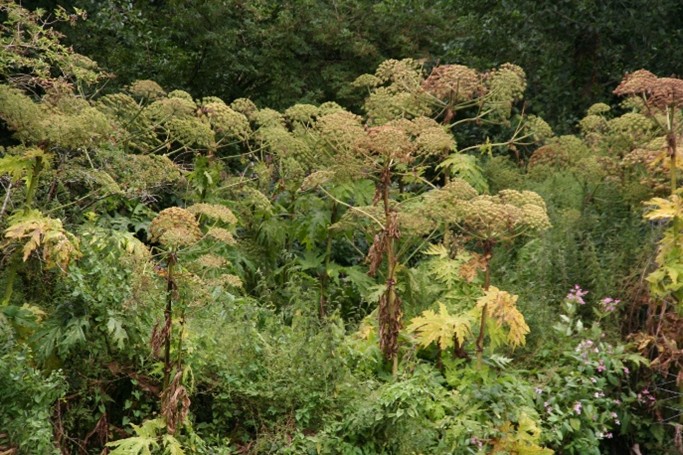
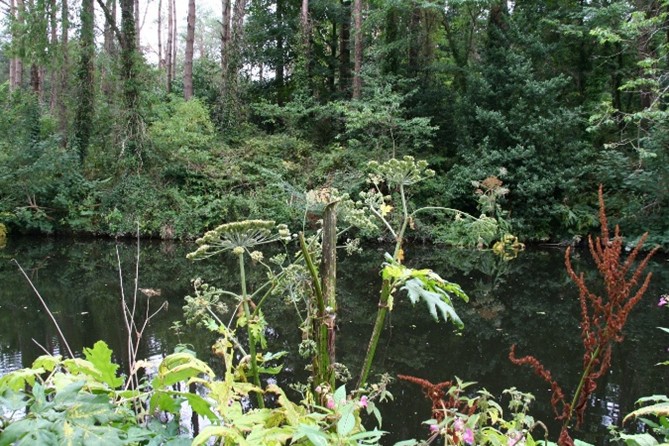
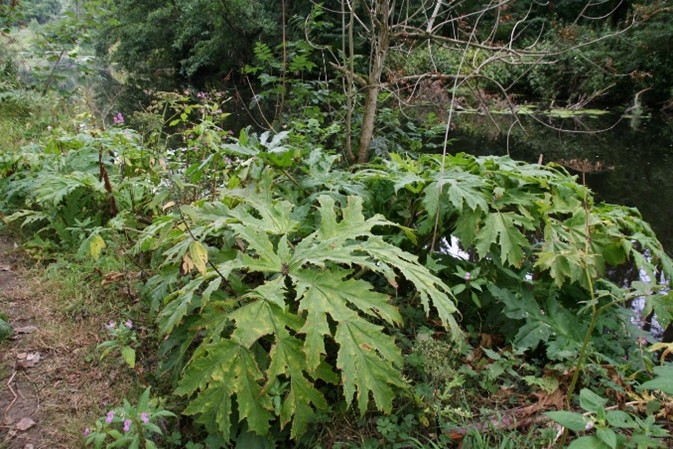
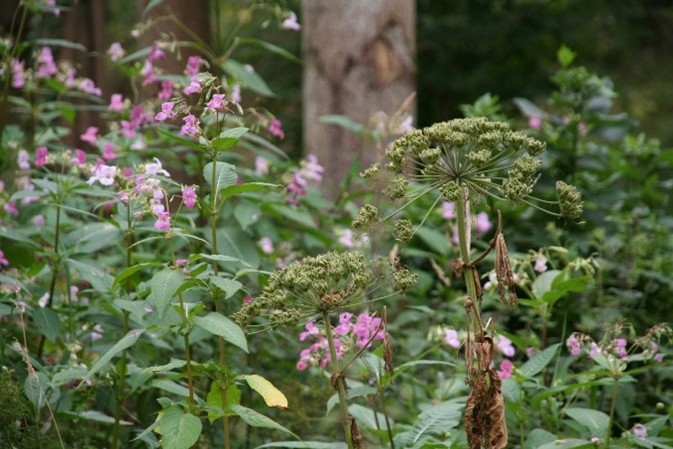
Giant hogweed large and tall stands on the riverbanks of the Lagan River (Belfast, Northern Ireland), sometimes sharing habitat with Himalayan balsam (Photo: Louis Simon).
Zebra mussel (Dreissena polymorpha)
The zebra mussel is a small freshwater mussel species native to the Caspian and Black Sea region. This species was introduced across all Europe when large canal networks were built, travelling attached to the hulls of boats. It was first introduced in England and Scotland around the 1820’s and 1830’s, possibly attached to imported timber, and arrived in Ireland in 1944, probably attached to boat hulls sailing from Britain or imported second-hand boats.
Spreading through rivers and canals, it is now invasive in Northern Ireland. The zebra mussel can have multiple impacts, including disturbing nutrient cycles, increasing water clarity, decreasing plankton, affecting fish populations, causing the decline of native mussel species, or degradation of infrastructure by blocking pipes. The zebra mussel is partly responsible of the ecological crisis recently taking place in Lough Neagh. As filter feeders (species that filter the water to catch nutrients), zebra mussels intensively filter the water and increase water clarity in their surrounding environment. An increased water quality favours the growth of algae and weed (increased light exposure means increased photosynthesis), which coupled with pollution from agriculture and wastewater (excess nutrients) causes toxic algae to thrive into blooms. Major agal blooms have been observed in Lough Neagh over the recent years and will eventually decrease water quality and availability.
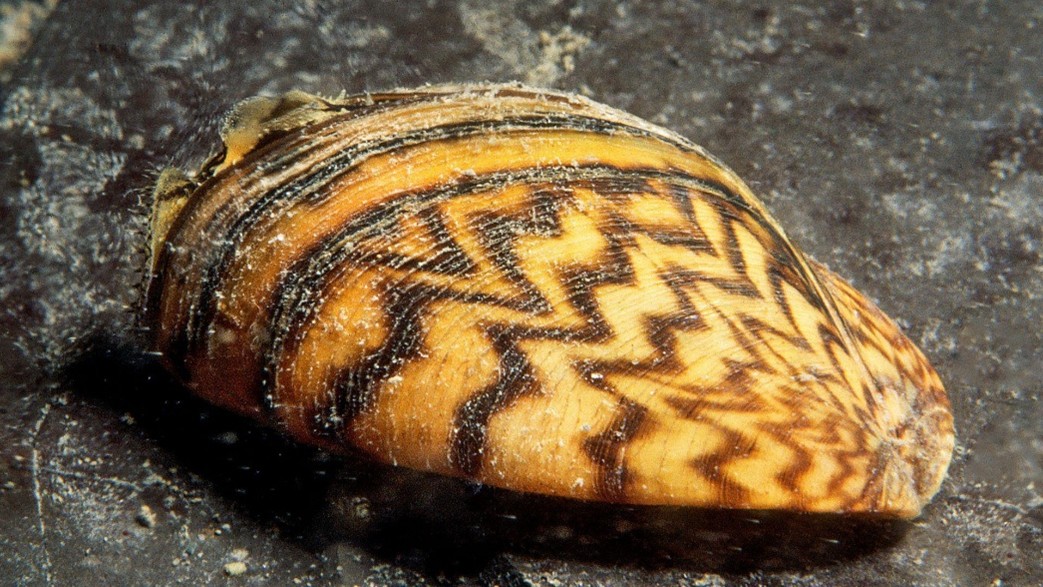
Zebra mussel (Photo: BBC).
Asian hornet (Vespa velutina)
The Asian hornet or yellow-legged hornet, native from East and Southeast Asia has been of major concern ever since it was first introduced in Europe. It was first reported in France in 2004 and has since then spread across most of mainland Europe (Spain, Portugal, Belgium, Italy, Germany, Netherlands, Luxembourg, Hungary). It was first recorded in the UK in 2016 in England (Gloucestershire). After a first isolated specimen observed in 2021 in Dublin, the first nests were reported in Ireland in Cork in early 2025. Researchers think that the invasion of mainland Europe, Great Britain, and Ireland is a continuous process, originating from a single mated queen accidently introduced in France in 2004 with a shipment of good imported from China.
Recently, on the 10th of October 2025, the Northern Ireland Environment Agency (NIEA) confirmed the sighting of an Asian hornet in the Dundonald area of Belfast. In the following days the NIEA confirmed the observation of more individuals, likely indicating the presence of a nest. This is the first ever record of the Asian hornet in Northern Ireland (Belfast Telegraph, DAERA).
The Asian hornet is a major concern as it has significant impacts on the environment, the economy and human health. It is a voracious predator of most pollinators, especially honeybees, which are almost defenceless against this new threat. The decrease in key pollinators caused by the Asian hornet greatly disturbs the plant communities and threatens the plants species that depend on them. Due to the damages it causes in apiculture (reduced size or loss of hives, loss of honeybee-derived products), in pollination services and the massive management efforts it requires, the Asian hornet also causes great monetary cost.
The Asian hornet also is a threat for human health. This highly aggressive species will defend its nest fiercely and will not hesitate to attack anything that gets relatively close or that is considered a threat for the colony. Since it attacks in in big groups and because its venom is allergenic, the Asian hornet has caused great numbers of injuries where it is invasive and can rarely cause potentially lethal anaphylactic shock to allergic people. In the case a nest is spotted, the Department of Agriculture, Environment and Rural Affairs (DAERA) recommends keeping distance, leaving it undisturbed and reporting it immediately.
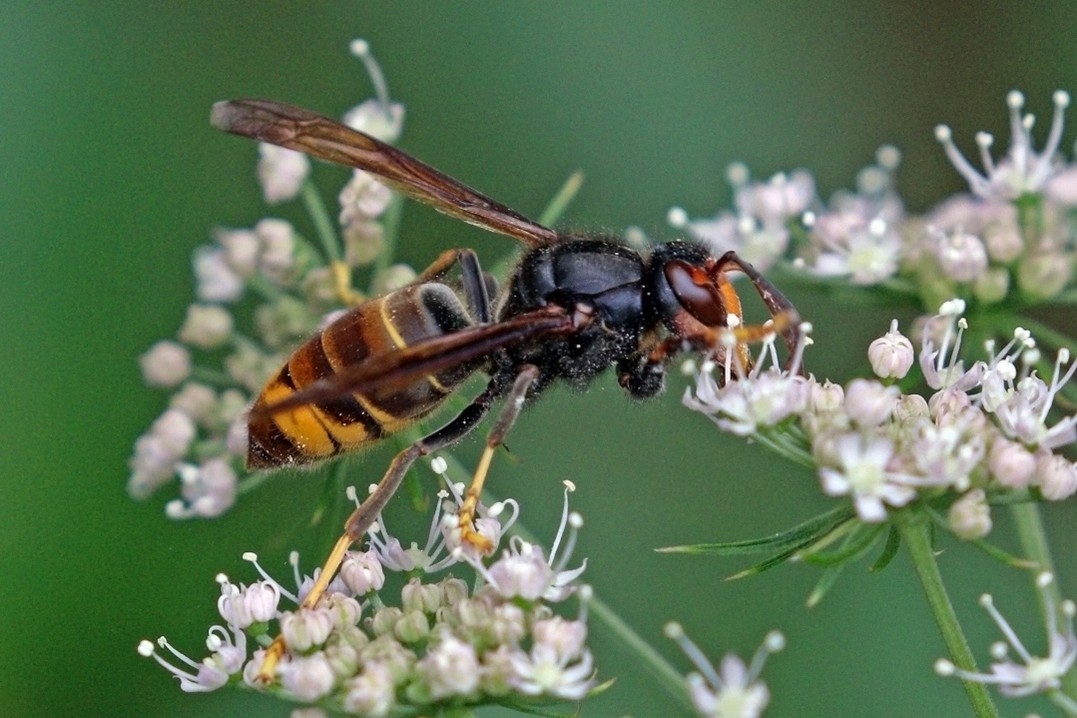
Asian hornet (Photo: Charles J. Sharp).
In summary, biological invasions are not a new phenomenon but have intensified recently due to the acceleration of human activities and globalisation. Invasive species are an issue and gather increasing concern as they can negatively impact the environment, can lead to massive economic losses and can pose risks to public health, including in the UK and Ireland.
More information
If you want more information about invasive species, which species are invasive where you live, what to do when you spot them or what you can do to help management, visit the following websites:
- Northern Ireland: https://invasivespeciesni.co.uk/
- Great Britain: https://www.nonnativespecies.org/non-native-species
- Ireland: https://invasives.ie/introduction/

